Battery Alfa Romeo Giulietta 2015 Owner's Manual
[x] Cancel search | Manufacturer: ALFA ROMEO, Model Year: 2015, Model line: Giulietta, Model: Alfa Romeo Giulietta 2015Pages: 288, PDF Size: 7.34 MB
Page 6 of 288
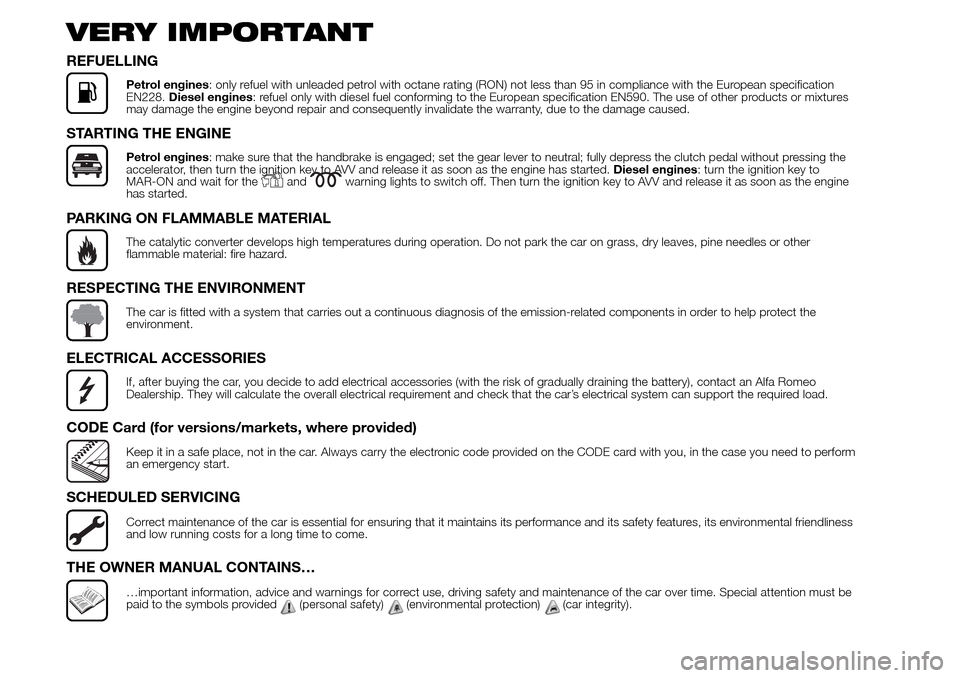
VERY IMPORTANT
REFUELLING
Petrol engines: only refuel with unleaded petrol with octane rating (RON) not less than 95 in compliance with the European specification
EN228.Diesel engines: refuel only with diesel fuel conforming to the European specification EN590. The use of other products or mixtures
may damage the engine beyond repair and consequently invalidate the warranty, due to the damage caused.
STARTING THE ENGINE
Petrol engines: make sure that the handbrake is engaged; set the gear lever to neutral; fully depress the clutch pedal without pressing the
accelerator, then turn the ignition key to AVV and release it as soon as the engine has started.Diesel engines: turn the ignition key to
MAR-ON and wait for the
andwarning lights to switch off. Then turn the ignition key to AVV and release it as soon as the engine
has started.
PARKING ON FLAMMABLE MATERIAL
The catalytic converter develops high temperatures during operation. Do not park the car on grass, dry leaves, pine needles or other
flammable material: fire hazard.
RESPECTING THE ENVIRONMENT
The car is fitted with a system that carries out a continuous diagnosis of the emission-related components in order to help protect the
environment.
ELECTRICAL ACCESSORIES
If, after buying the car, you decide to add electrical accessories (with the risk of gradually draining the battery), contact an Alfa Romeo
Dealership. They will calculate the overall electrical requirement and check that the car’s electrical system can support the required load.
CODE Card (for versions/markets, where provided)
Keep it in a safe place, not in the car. Always carry the electronic code provided on the CODE card with you, in the case you need to perform
an emergency start.
SCHEDULED SERVICING
Correct maintenance of the car is essential for ensuring that it maintains its performance and its safety features, its environmental friendliness
and low running costs for a long time to come.
THE OWNER MANUAL CONTAINS…
…important information, advice and warnings for correct use, driving safety and maintenance of the car over time. Special attention must be
paid to the symbols provided (personal safety)(environmental protection) (car integrity).
Page 16 of 288

Door and luggage
compartment lock
release
Briefly press button
: unlocking of
doors, timed switching on of internal
roof lights and double flashing of
direction indicators (for versions/
markets, where provided).
The doors are unlocked automatically if
the fuel cut-off system intervenes.
Once the doors are locked, if one or
more doors or the luggage
compartment are not closed correctly,
the LED and direction indicators start
flashing quickly.
Door and luggage
compartment locking
Briefly press button
: locking of
doors, switching off of internal roof
lights and single flashing of direction
indicators (for versions/markets, where
provided).
If one or more door are open, the doors
will not be locked. This is indicated by
a rapid flashing of the direction
indicators (for versions/markets, where
provided). The doors will be locked if
the tailgate is open however.When a speed of over 20 km/h is
reached, the doors are automatically
locked if this specific function has been
set (only on versions with "Multi-
function reconfigurable display").
When the doors are locked from
outside the car (using the remote
control), LED A fig. 8 will switch on for a
few seconds and then start flashing
(deterrent function).
When the doors are locked from inside
the car (by pressing the
button on
the dashboard) the LED will remain on
constantly.Opening the luggage
compartment
Press the
button to open the
luggage compartment remotely. The
direction indicators will flash twice
to indicate that the luggage
compartment has been opened.
REQUESTING
ADDITIONAL REMOTE
CONTROLS
The system can recognise up to 8 keys
with incorporated remote control. If
you need to request a new remote
control, contact an Alfa Romeo
Dealership, taking the CODE Card (for
versions/markets, where provided),
an identity document and documents
proving ownership of the car with you.
REPLACING THE
BATTERY IN THE KEY
WITH REMOTE CONTROL
Procedure
1)
❒press button A fig. 9 and move the
metal insert B to opening position;
turn screw C to
using a fine
bit screwdriver;
8A0K0588
12
GETTING TO KNOW YOUR CAR
Page 17 of 288
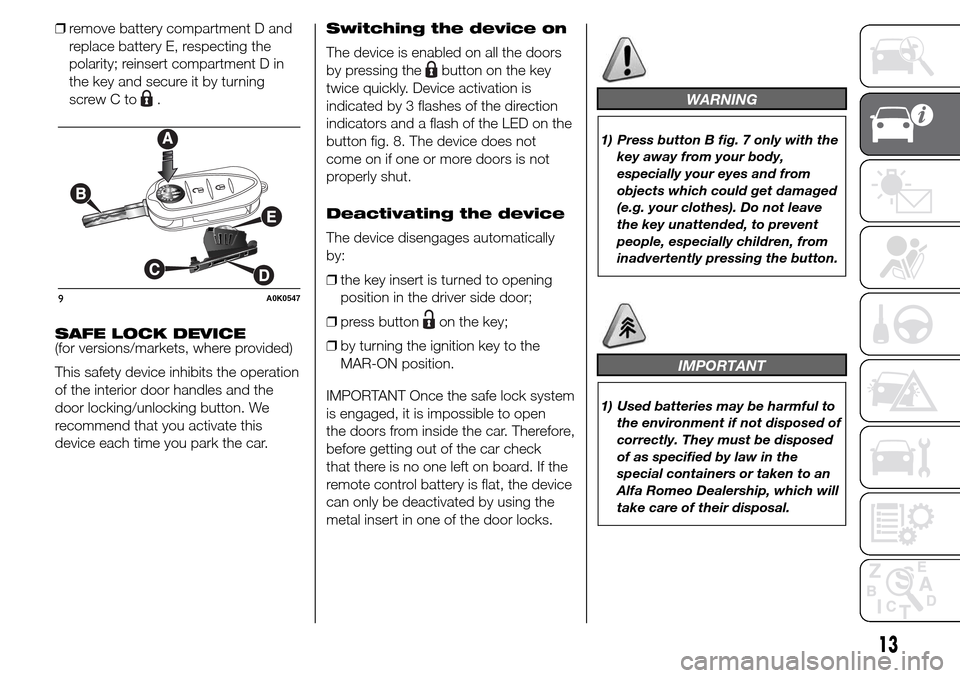
❒remove battery compartment D and
replace battery E, respecting the
polarity; reinsert compartment D in
the key and secure it by turning
screw C to
.
SAFE LOCK DEVICE
(for versions/markets, where provided)
This safety device inhibits the operation
of the interior door handles and the
door locking/unlocking button. We
recommend that you activate this
device each time you park the car.Switching the device on
The device is enabled on all the doors
by pressing the
button on the key
twice quickly. Device activation is
indicated by 3 flashes of the direction
indicators and a flash of the LED on the
button fig. 8. The device does not
come on if one or more doors is not
properly shut.
Deactivating the device
The device disengages automatically
by:
❒the key insert is turned to opening
position in the driver side door;
❒press button
on the key;
❒by turning the ignition key to the
MAR-ON position.
IMPORTANT Once the safe lock system
is engaged, it is impossible to open
the doors from inside the car. Therefore,
before getting out of the car check
that there is no one left on board. If the
remote control battery is flat, the device
can only be deactivated by using the
metal insert in one of the door locks.
WARNING
1) Press button B fig. 7 only with the
key away from your body,
especially your eyes and from
objects which could get damaged
(e.g. your clothes). Do not leave
the key unattended, to prevent
people, especially children, from
inadvertently pressing the button.
IMPORTANT
1) Used batteries may be harmful to
the environment if not disposed of
correctly. They must be disposed
of as specified by law in the
special containers or taken to an
Alfa Romeo Dealership, which will
take care of their disposal.
9A0K0547
13
Page 18 of 288
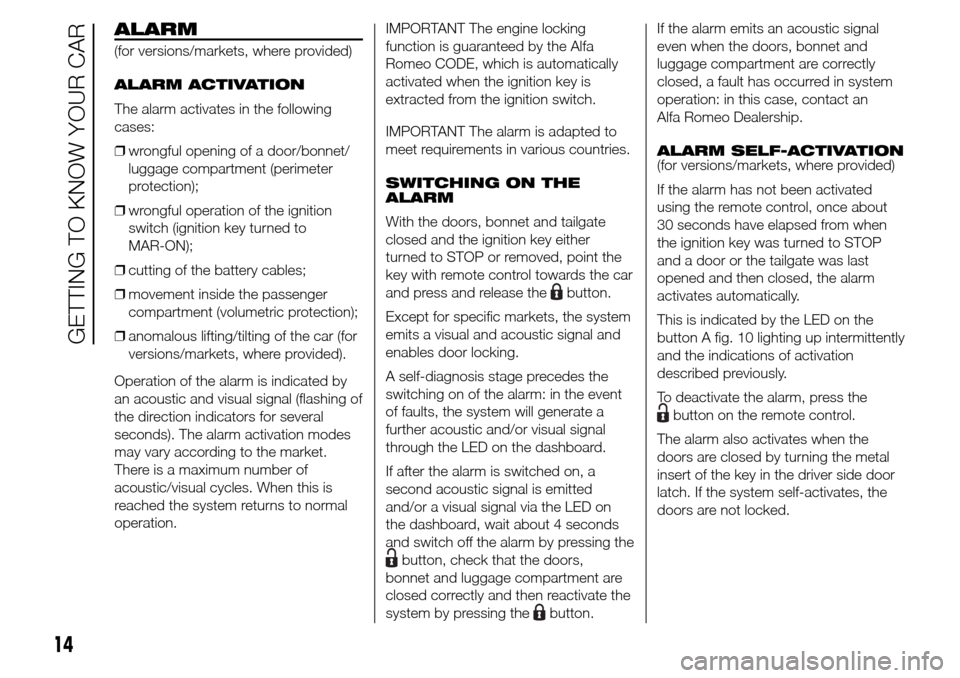
ALARM
(for versions/markets, where provided)
ALARM ACTIVATION
The alarm activates in the following
cases:
❒wrongful opening of a door/bonnet/
luggage compartment (perimeter
protection);
❒wrongful operation of the ignition
switch (ignition key turned to
MAR-ON);
❒cutting of the battery cables;
❒movement inside the passenger
compartment (volumetric protection);
❒anomalous lifting/tilting of the car (for
versions/markets, where provided).
Operation of the alarm is indicated by
an acoustic and visual signal (flashing of
the direction indicators for several
seconds). The alarm activation modes
may vary according to the market.
There is a maximum number of
acoustic/visual cycles. When this is
reached the system returns to normal
operation.IMPORTANT The engine locking
function is guaranteed by the Alfa
Romeo CODE, which is automatically
activated when the ignition key is
extracted from the ignition switch.
IMPORTANT The alarm is adapted to
meet requirements in various countries.
SWITCHING ON THE
ALARM
With the doors, bonnet and tailgate
closed and the ignition key either
turned to STOP or removed, point the
key with remote control towards the car
and press and release the
button.
Except for specific markets, the system
emits a visual and acoustic signal and
enables door locking.
A self-diagnosis stage precedes the
switching on of the alarm: in the event
of faults, the system will generate a
further acoustic and/or visual signal
through the LED on the dashboard.
If after the alarm is switched on, a
second acoustic signal is emitted
and/or a visual signal via the LED on
the dashboard, wait about 4 seconds
and switch off the alarm by pressing the
button, check that the doors,
bonnet and luggage compartment are
closed correctly and then reactivate the
system by pressing the
button.If the alarm emits an acoustic signal
even when the doors, bonnet and
luggage compartment are correctly
closed, a fault has occurred in system
operation: in this case, contact an
Alfa Romeo Dealership.
ALARM SELF-ACTIVATION
(for versions/markets, where provided)
If the alarm has not been activated
using the remote control, once about
30 seconds have elapsed from when
the ignition key was turned to STOP
and a door or the tailgate was last
opened and then closed, the alarm
activates automatically.
This is indicated by the LED on the
button A fig. 10 lighting up intermittently
and the indications of activation
described previously.
To deactivate the alarm, press the
button on the remote control.
The alarm also activates when the
doors are closed by turning the metal
insert of the key in the driver side door
latch. If the system self-activates, the
doors are not locked.
14
GETTING TO KNOW YOUR CAR
Page 39 of 288

ADDITIONAL HEATER
(for versions/markets, where provided)
This allows the passenger
compartment to be heated more
quickly in cold weather conditions. The
additional heater turns off automatically
after the required comfort conditions
are achieved.
Automatic dual zone
climate control system
(for versions/markets, where provided)
The additional heater activates
automatically depending on the
environmental conditions and with
engine started.
Manual climate control
system
The additional heater activates
automatically when knob A is turned to
the end of the red section and the fan
is set to at least 1
stspeed.
IMPORTANT The heater only works if
the outside temperature and engine
coolant temperature are low. The heater
will not activate if the battery voltage is
too low.
IMPORTANT
2) The climate control system
detects the passenger
compartment temperature with a
mean radiant temperature sensor
fitted in a cover under the internal
rear view mirror. Obstructing the
field of view of this sensor with
any object could cause the
climate control system to operate
with less than optimal efficiency
.
EXTERNAL LIGHTS
IN BRIEF
The left stalk fig. 31 operates most of
the external lights. The external
lights can only be switched on when
the ignition key is at MAR-ON.
The instrument panel and the
dashboard and central tunnel
controls will light up together with the
external lights.
DAYTIME RUNNING
LIGHTS (DRL)
“Daytime Running Lights”
With the ignition key at MAR-ON and
ring nut A fig. 31 turned to
, the
daytime running lights switch on. The
other lights and interior lighting stay off.
31A0K0556
35
Page 46 of 288

❒by pressing the brake pedal, the
clutch or the accelerator; in this
last case the system is not effectively
deactivated but the system gives
priority to the acceleration request.
The device still remains active,
without the need to press the RES
button to return to the previous
conditions once acceleration
is concluded.
Automatic deactivation
The device deactivates automatically in
the following cases:
❒if the ABS or ESC systems intervene;
❒with the car speed below the set
limit;
❒in the event of system failure.
15) 16)
WARNING
15) When travelling with the device
active, do not move the gear lever
to neutral.
16) In the event of device faults or
failures, turn the ring nut A to
OFF and contact an Alfa Romeo
Dealership.
ROOF LIGHTS
FRONT ROOF LIGHT
Switch A fig. 35 switches the roof lights
on/off.
A switch positions:
❒central position: lights C and E switch
on/off when the doors are opened/
closed;
❒pressed to the left(position OFF):
lights C and E are always switched
off;
❒pressed to the right(position
):
lights C and E are always switched
on.
Lights switch on/off progressively.
Switch B switches light C on/off.
Switch D switches light E on/off.IMPORTANT Before getting out of the
car, make sure that both switches are in
the central position: when the doors
are closed the lights will switch off
to avoid draining the battery.
In any case, if the switch is left
inadvertently in the permanently on
position, the roof light will turn off
automatically 15 minutes after the
engine stopping.
ROOF LIGHT TIMING
On certain versions, to facilitate getting
in/out of the car at night or in poorly-lit
areas, two timed modes have been
provided.
Timing when getting into
the car
The roof lights switch on according to
the following modes:
❒for about 10 seconds when the
doors are unlocked;
❒for about 3 minutes when one of the
doors is opened;
❒for about 10 seconds when the
doors are closed.
The timed period is interrupted when
the ignition key is turned to MAR.
35A0K0805
42
GETTING TO KNOW YOUR CAR
Page 49 of 288
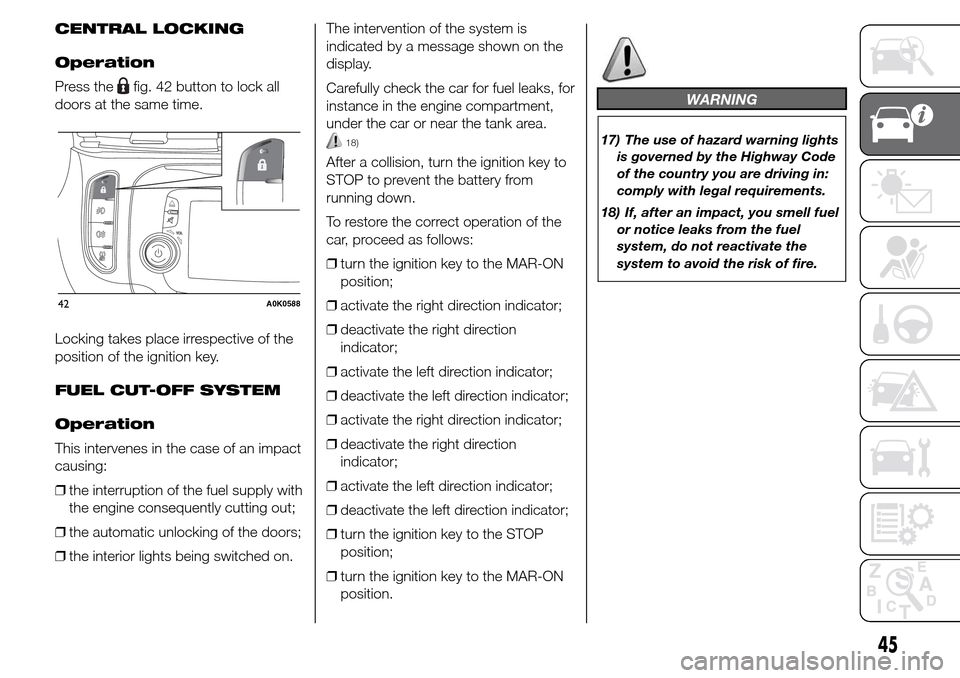
CENTRAL LOCKING
Operation
Press the
fig. 42 button to lock all
doors at the same time.
Locking takes place irrespective of the
position of the ignition key.
FUEL CUT-OFF SYSTEM
Operation
This intervenes in the case of an impact
causing:
❒the interruption of the fuel supply with
the engine consequently cutting out;
❒the automatic unlocking of the doors;
❒the interior lights being switched on.The intervention of the system is
indicated by a message shown on the
display.
Carefully check the car for fuel leaks, for
instance in the engine compartment,
under the car or near the tank area.
18)
After a collision, turn the ignition key to
STOP to prevent the battery from
running down.
To restore the correct operation of the
car, proceed as follows:
❒turn the ignition key to the MAR-ON
position;
❒activate the right direction indicator;
❒deactivate the right direction
indicator;
❒activate the left direction indicator;
❒deactivate the left direction indicator;
❒activate the right direction indicator;
❒deactivate the right direction
indicator;
❒activate the left direction indicator;
❒deactivate the left direction indicator;
❒turn the ignition key to the STOP
position;
❒turn the ignition key to the MAR-ON
position.
WARNING
17) The use of hazard warning lights
is governed by the Highway Code
of the country you are driving in:
comply with legal requirements.
18) If, after an impact, you smell fuel
or notice leaks from the fuel
system, do not reactivate the
system to avoid the risk of fire.
42A0K0588
45
Page 54 of 288
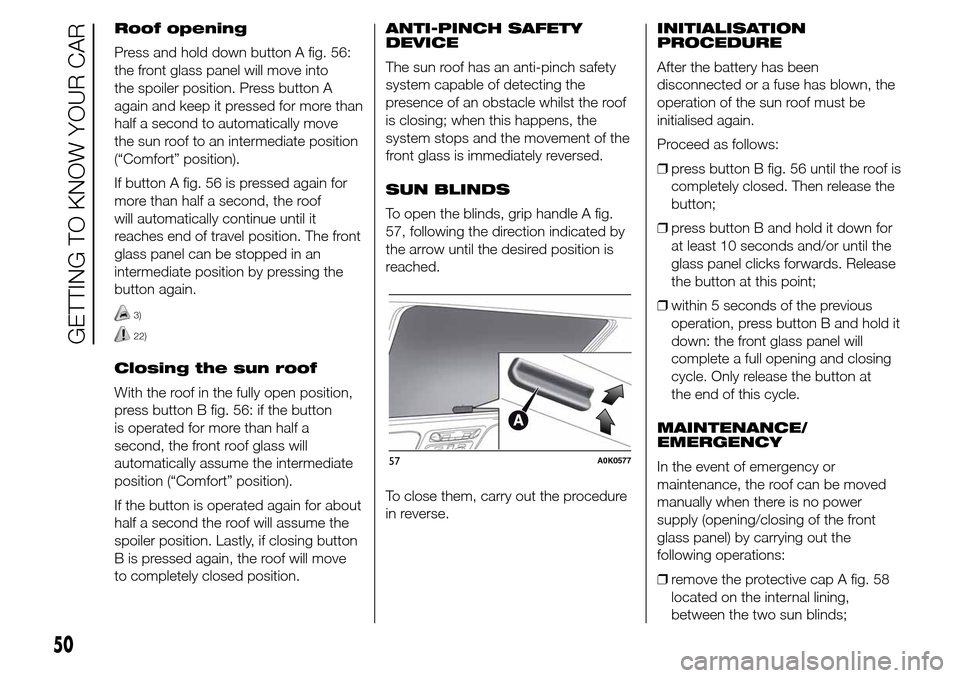
Roof opening
Press and hold down button A fig. 56:
the front glass panel will move into
the spoiler position. Press button A
again and keep it pressed for more than
half a second to automatically move
the sun roof to an intermediate position
(“Comfort” position).
If button A fig. 56 is pressed again for
more than half a second, the roof
will automatically continue until it
reaches end of travel position. The front
glass panel can be stopped in an
intermediate position by pressing the
button again.
3)
22)
Closing the sun roof
With the roof in the fully open position,
press button B fig. 56: if the button
is operated for more than half a
second, the front roof glass will
automatically assume the intermediate
position (“Comfort” position).
If the button is operated again for about
half a second the roof will assume the
spoiler position. Lastly, if closing button
B is pressed again, the roof will move
to completely closed position.ANTI-PINCH SAFETY
DEVICE
The sun roof has an anti-pinch safety
system capable of detecting the
presence of an obstacle whilst the roof
is closing; when this happens, the
system stops and the movement of the
front glass is immediately reversed.
SUN BLINDS
To open the blinds, grip handle A fig.
57, following the direction indicated by
the arrow until the desired position is
reached.
To close them, carry out the procedure
in reverse.INITIALISATION
PROCEDURE
After the battery has been
disconnected or a fuse has blown, the
operation of the sun roof must be
initialised again.
Proceed as follows:
❒press button B fig. 56 until the roof is
completely closed. Then release the
button;
❒press button B and hold it down for
at least 10 seconds and/or until the
glass panel clicks forwards. Release
the button at this point;
❒within 5 seconds of the previous
operation, press button B and hold it
down: the front glass panel will
complete a full opening and closing
cycle. Only release the button at
the end of this cycle.
MAINTENANCE/
EMERGENCY
In the event of emergency or
maintenance, the roof can be moved
manually when there is no power
supply (opening/closing of the front
glass panel) by carrying out the
following operations:
❒remove the protective cap A fig. 58
located on the internal lining,
between the two sun blinds;
57A0K0577
50
GETTING TO KNOW YOUR CAR
Page 56 of 288
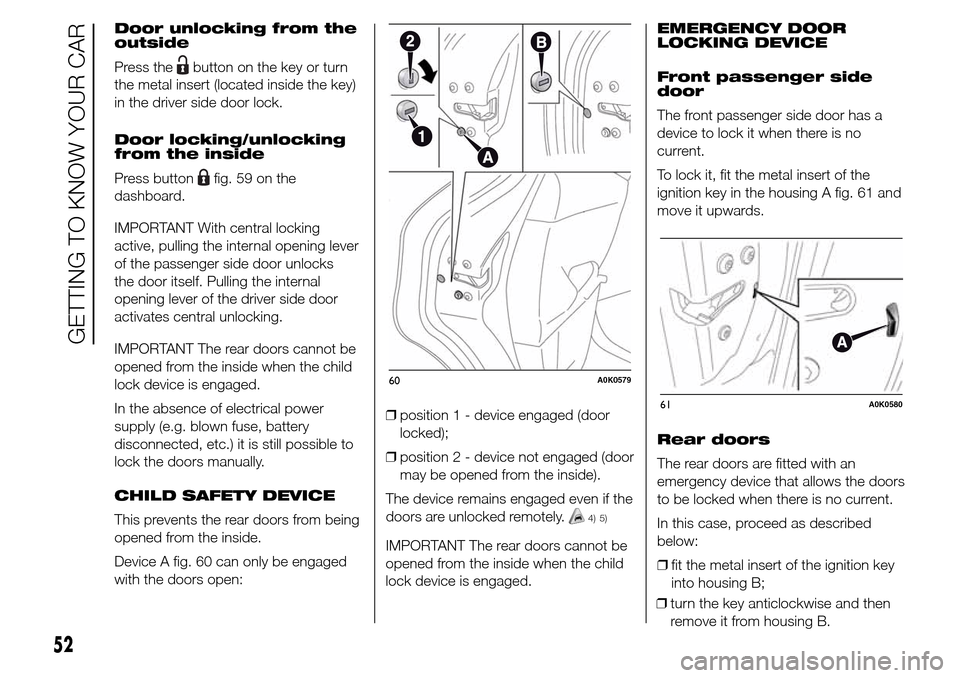
Door unlocking from the
outside
Press the
button on the key or turn
the metal insert (located inside the key)
in the driver side door lock.
Door locking/unlocking
from the inside
Press button
fig. 59 on the
dashboard.
IMPORTANT With central locking
active, pulling the internal opening lever
of the passenger side door unlocks
the door itself. Pulling the internal
opening lever of the driver side door
activates central unlocking.
IMPORTANT The rear doors cannot be
opened from the inside when the child
lock device is engaged.
In the absence of electrical power
supply (e.g. blown fuse, battery
disconnected, etc.) it is still possible to
lock the doors manually.
CHILD SAFETY DEVICE
This prevents the rear doors from being
opened from the inside.
Device A fig. 60 can only be engaged
with the doors open:❒position 1 - device engaged (door
locked);
❒position 2 - device not engaged (door
may be opened from the inside).
The device remains engaged even if the
doors are unlocked remotely.
4) 5)
IMPORTANT The rear doors cannot be
opened from the inside when the child
lock device is engaged.EMERGENCY DOOR
LOCKING DEVICE
Front passenger side
door
The front passenger side door has a
device to lock it when there is no
current.
To lock it, fit the metal insert of the
ignition key in the housing A fig. 61 and
move it upwards.
Rear doors
The rear doors are fitted with an
emergency device that allows the doors
to be locked when there is no current.
In this case, proceed as described
below:
❒fit the metal insert of the ignition key
into housing B;
60A0K0579
61A0K0580
52
GETTING TO KNOW YOUR CAR
❒turn the key anticlockwise and then
remove it from housing B.
Page 57 of 288
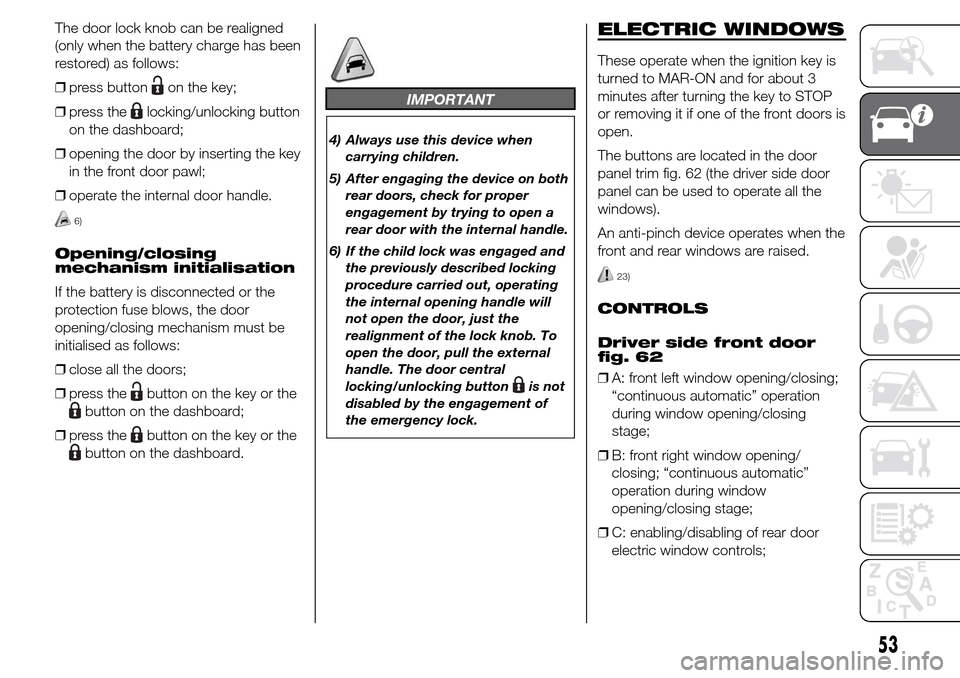
The door lock knob can be realigned
(only when the battery charge has been
restored) as follows:
❒press button
on the key;
❒press the
locking/unlocking button
on the dashboard;
❒opening the door by inserting the key
in the front door pawl;
❒operate the internal door handle.
6)
Opening/closing
mechanism initialisation
If the battery is disconnected or the
protection fuse blows, the door
opening/closing mechanism must be
initialised as follows:
❒close all the doors;
❒press the
button on the key or the
button on the dashboard;
❒press the
button on the key or the
button on the dashboard.
IMPORTANT
4) Always use this device when
carrying children.
5) After engaging the device on both
rear doors, check for proper
engagement by trying to open a
rear door with the internal handle.
6) If the child lock was engaged and
the previously described locking
procedure carried out, operating
the internal opening handle will
not open the door, just the
realignment of the lock knob. To
open the door, pull the external
handle. The door central
locking/unlocking button
is not
disabled by the engagement of
the emergency lock.
ELECTRIC WINDOWS
These operate when the ignition key is
turned to MAR-ON and for about 3
minutes after turning the key to STOP
or removing it if one of the front doors is
open.
The buttons are located in the door
panel trim fig. 62 (the driver side door
panel can be used to operate all the
windows).
An anti-pinch device operates when the
front and rear windows are raised.
23)
CONTROLS
Driver side front door
fig. 62
❒A: front left window opening/closing;
“continuous automatic” operation
during window opening/closing
stage;
❒B: front right window opening/
closing; “continuous automatic”
operation during window
opening/closing stage;
❒C: enabling/disabling of rear door
electric window controls;
53